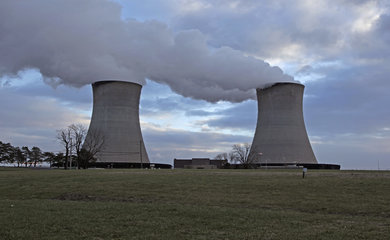by Lauren Wissot
Premiering at this past Sundance Film Festival, Don Argott and Sheena M. Joyce’s “The Atomic States of America” is now coming to a digital – here’s to iTunes and Netflix! – format near you. Unsurprisingly, given that Argott is one of the forces behind “Last Days Here,” last year’s winner of the music doc category at the International Documentary Film Festival Amsterdam (and for more on that flick, see my interview for Global Comment with Argott and his longtime editor and co-director Demian Fenton), “Atomic States” is a refreshingly entertaining look at a very thorny social issue. Based on Kelly McMasters’s memoir about life in her Long Island, nuclear-reactor hometown, the film eloquently universalizes the many risks of “going green” – or as McMasters likes to say, “We all live downstream from something.” I spoke with the passionate co-directors prior to the film’s (Sundance Institute Artist Services Initiative-enabled) January15th release.
Lauren Wissot: So how did this project originally come about? I know the film is based on Kelly McMasters’s book – did you know her prior to the shoot?
Don Argott: Our manager had given us the book “Welcome to Shirley: A Memoir from an Atomic Town” written by Kelly McMasters. It’s a memoir about Kelly’s experience growing up in Shirley, Long Island in the shadow of the Brookhaven National Lab. Brookhaven was a government laboratory that had three working nuclear reactors on the premises for atomic research, all of which had leaked into the ground water for decades. The lab also sits atop Long Island’s aquifer, which the town gets its drinking water from. Needless to say, there have been countless unexplained cancer clusters in the area – breast cancer, thyroid cancer and many rare childhood cancers. Sheena and I really loved the book and were blown away that there was such a seemingly huge story that was, in essence, hidden in plain site. When we were doing research for the film, we decided that we needed to expand the story past Long Island and look at reactor communities around the country. All this was happening as Obama was restarting our nation’s long stalled nuclear program by providing loan guarantees for the first new nuclear power plant in almost 32 years. We felt that we were onto something very topical.
LW: Don, “Atomic States” really surprised me for a number of reasons, not least of which because your previous doc “Last Days Here,” co-directed with your longtime editor Demian Fenton, follows the heroin-addicted front man of the hard rock band Pentagram. And recently you’d been touring the world filming the heavy metal band Lamb of God. (Though I guess the lead singer’s manslaughter indictment has put you on hiatus.) Do you see “Atomic States” as a radical departure from your other work – or are there indeed similarities?
DA: I think the one common thing we look for is great stories. That’s our criteria. So sometimes we end up in sub-basements with a crack-head, sometimes we’re in the Czech Republic following a manslaughter case, and sometimes we are filming nuclear accident simulations at Indian Point. It’s one of the more exhilarating things about making documentaries, because you find yourself in the most unexpected places. But I don’t see “Atomic States” as a radical departure. It’s just that we don’t tend to make the same kind of film each time out.
LW: Speaking of surprises, what was the biggest one for you during the course of production? Did your views towards nuclear energy change at all, and if so, how?
Sheena M. Joyce: Well, reading Kelly’s book, we certainly had a more critical view of this technology, but we honestly didn’t go into making the film with an agenda. With a film like this we always try and get both sides of the issue, but sometimes that proves difficult when the other side doesn’t want to talk. We really wanted to tell the story through the eyes of the people living within these communities. Whenever we were finished with an interview, talking to people that have been battling the industry sometimes for decades, we’d ask, “What’s it going to take for people to wake up to the severity of this technology?” Everyone that we talked to basically said the same thing – it’s unfortunately going to take another catastrophe for people to pay attention. Almost a year into making the film, the Fukushima accident started on March 11th, and we started remaking the film on March 12th.
LW: Can you talk a bit about the Sundance Institute’s Artists Services initiative that you’re working with on the upcoming release of “Atomic States”? How did you get involved with that?
SMJ: The Artists Initiative program has been really great. The Institute has really been behind us, they believe in the film and they’re excited to get it out. Distribution landscapes are changing rapidly for independent film. Distributors are becoming more and more reluctant to take on specialty films if they don’t feel like there’s a wide enough audience. But there are so many great films being made that, inevitably, some films are going to slip through the cracks. Artists Services realizes that these films need to be made available to the public, and they are committed to help get them seen.
LW: Finally, what do you hope audiences will take away from the film? Are you looking to spark interest in other forms of alternative energy?
DA: I think all we can hope for is that it sparks a dialogue and people educate themselves about the pros and cons of this technology. The fact is that these plants are all getting older, and there have been three significant nuclear accidents in the past 32 years. We need to weigh out what all this costs, not just financial, but the human cost involved.

